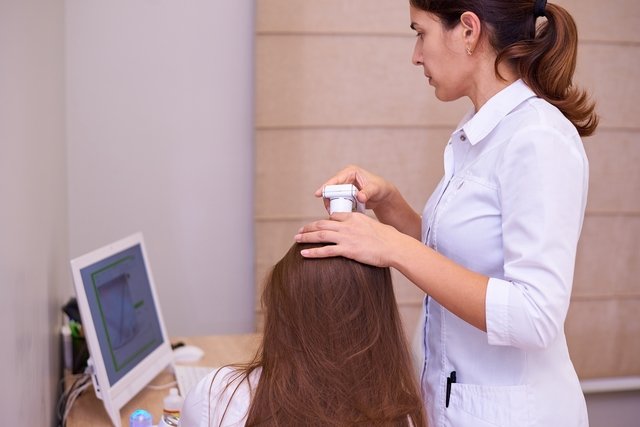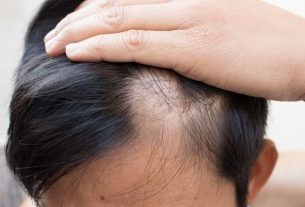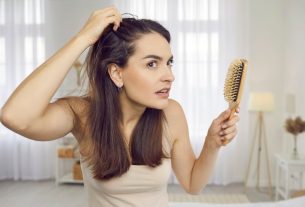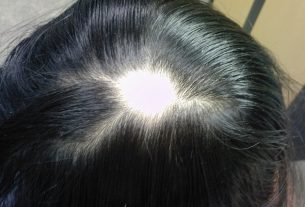Alopecia is a condition that, in some cases, can be cured when it is diagnosed and treated correctly by a dermatologist, who can prescribe the use of oral medications, such as finasteride and spironolactone, or topical medications, such as minoxidil and alfaestradiol, for example.
However, alopecia areata, androgenetic alopecia and cicatricial, or frontal fibrosing, alopecia have no cure. In these cases, the treatment recommended by the doctor helps control hair loss, reduce defects and prevent others from happening.
Alopecia is the loss of hair from the scalp or hair from any other part of the body, such as the beard, legs and arms. In alopecia, hair and hair fall out in large quantities, exposing the area of skin or scalp that was previously covered.
Read too: Alopecia: what it is, symptoms, causes, types and treatment

Is alopecia curable?
Some types of alopecia, such as seborrheic, traction and telogen effluvium, can be cured when diagnosed and treated in the initial phase by a dermatologist.
Some types of this disease, such as alopecia areata, androgenetic alopecia and cicatricial alopecia, or frontal fibrosing, have no cure. In these types, medical treatment helps control inflammation and hair loss, reducing or preventing new hair loss.
Is there a cure for female alopecia?
Female alopecia, also known as female androgenetic alopecia, has no cure. However, appropriate treatment can promote the growth of new hair, improving appearance and preventing hair loss. Learn more about androgenetic alopecia.
Main treatments for alopecia
The main treatments recommended for alopecia are:
1. Oral remedies
Oral medications such as minoxidil, finasteride and spironolactone may be indicated in cases of androgenetic alopecia, traction and telogen effluvium, to promote healthy hair growth and delay hair loss, as they stimulate blood circulation, prolonging the hair growth phase.
In more serious cases of alopecia areata, the doctor may also prescribe the use of corticosteroids and immunosuppressants.
2. Topical medications
For the treatment of alopecia areata, androgenetic and scarring, the doctor may recommend the use of topical medications, such as minoxidil lotion and finasteride, which should be applied to the area with hair loss.
3. Lasertherapy
Laser therapy is a treatment carried out with a low-power laser that reduces inflammation and has healing properties. Therefore, this treatment may be indicated in the early stages of some types of alopecia, helping to recover hair follicles.
Read too: Laser therapy: what it is, what it is for and when it is indicated
4. Hair mesotherapy
Hair mesotherapy is a technique that consists of applying injections with vitamins, amino acids, corticosteroids and/or minoxidil, for example, which promote hair growth.
This treatment may be indicated in cases of alopecia areata and cicatricial, for example. Understand better how hair mesotherapy is performed.
5. Hair transplant
Hair transplantation is a surgical treatment performed by removing strands of the person’s own hair to be transplanted into areas without hair, providing a more natural appearance. Hair transplantation may be indicated in cases of androgenetic, cicatricial or traumatic alopecia, for example.
Read too: Hair transplant: what it is, when it is indicated, how it is done and results
6. Supplements
Some supplements containing B vitamins, zinc, iron, selenium and vitamin A may be recommended by a doctor or nutritionist mainly to help treat alopecia caused by a deficiency of these nutrients. Check out the main vitamins and minerals recommended for hair loss.
Bibliography
- TREASURE ISLAND (FL): STATPEARLS PUBLISHING. Frontal Fibrosing Alopecia. Available at: <https://www.ncbi.nlm.nih.gov/books/NBK519001/>. Accessed on February 28, 2024
- TREASURE ISLAND (FL): STATPEARLS PUBLISHING. Traction Alopecia. Available at: <https://www.ncbi.nlm.nih.gov/books/NBK470434/>. Accessed on February 28, 2024
- BRAZILIAN SOCIETY OF REGIONAL DERMATOLOGY SÃO PAULO. Alopecia frontal fibrosante. Available at: <https://www.sbd-sp.org.br/geral/causas-tratamentos-e-identificacao-da-alopecia-frontal-fibrosante/>. Accessed on February 28, 2024
- TREASURE ISLAND (FL): STATPEARLS PUBLISHING. Androgenetic Alopecia. Available at: <https://www.ncbi.nlm.nih.gov/books/NBK430924/>. Accessed on February 28, 2024
- TREASURE ISLAND (FL): STATPEARLS PUBLISHING. Alopecia Areata. Available at: <https://www.ncbi.nlm.nih.gov/books/NBK537000/>. Accessed on February 28, 2024

Sign up for our newsletter and stay up to date with exclusive news
that can transform your routine!
Warning: Undefined array key "title" in /home/storelat/public_html/wp-content/plugins/link-whisper-premium/templates/frontend/related-posts.php on line 12
Warning: Undefined array key "title_tag" in /home/storelat/public_html/wp-content/plugins/link-whisper-premium/templates/frontend/related-posts.php on line 13



